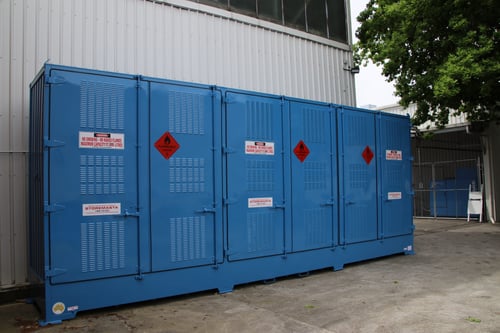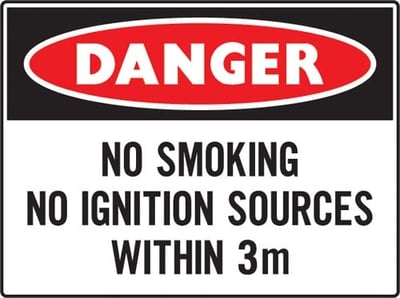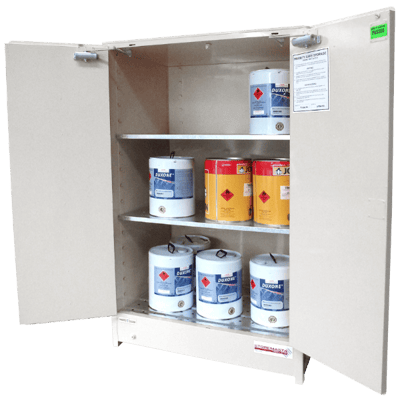If your organisation carries larger quantities of hazardous chemicals, choosing outdoor storage can be a safe and convenient option. In this blog, we’ll be looking at the requirements that relate to outdoor chemical storage in Australia. We’ll also be detailing how you can reduce risk in your business through implementing control measures such as spill containment and ventilation in your outdoor chemical storage areas.
Considering The Maximum Capacity Requirements
The first consideration you’ll need to make it to decide whether to store your chemicals in an indoor or outdoor location. The maximum capacity requirements for indoor safety cabinets may affect this decision.
Within the Australian Standards are the maximum capacity requirements for the storage of hazardous chemicals in indoor chemical storage cabinets. These requirements dictate the maximum aggregate quantities of hazardous chemicals that you can store in an indoor safety cabinet.
Indoor safety cabinets can store limited amounts of hazardous chemicals due to the maximum capacity requirements of the Australian Standards.
Our table lists each dangerous goods class and the relevant maximum capacity limits for storage in indoor cabinets:
|
Classification |
Maximum Capacity (L) |
|
Class 3 - Flammable Liquids |
850 |
|
Class 4 - Flammable Solids |
250 |
|
Division 5.1 - Oxidising Agents |
250 |
|
Division 5.2 - Organic Peroxides - Type B |
50 |
|
Division 5.2 - Organic Peroxides - Type C, D, E |
100 |
|
Division 5.2 - Organic Peroxides - Type F |
100 |
|
Division 6.1 - Toxic Substances |
250 |
|
Class 8 - Corrosive Substances |
850 |
The Location of Indoor Cabinets
In addition to the maximum capacity requirements listed above, the Standards also details further requirements which dictate how many cabinets can be used in an indoor environment.
For example, the Australian Standard which relates to Class 3 Flammable Liquids is AS 1940 – The storage and handling of flammable and combustible liquids.
In Section 4.9.6 Cabinet location, it states that the aggregate capacity of flammable cabinets shall not be greater than:
- 850 L per 250 m2 on ground floor area; or
- 250 L per 250 m2 on other floors
Each aggregate quantity must also be separated by a distance of at least 10 metres.
Other factors which can influence the location (and number) of your indoor safety cabinets include exclusion from ignition sources and providing a clear passage for emergency evacuations.
When determining your dangerous goods storage needs, it’s important to consider all the factors that relate to the safe indoor storage of hazardous chemicals. In many cases, it is a simpler and more convenient option to store larger quantities of chemicals in an outdoor environment.
We’ll look at the requirements that relate to outdoor chemical storage in the next section of this blog.
Outdoor Storage Of Hazardous Chemicals
When considering your outdoor storage requirements, you must keep in mind that your store is designed and manufactured in full conformance to the Australian Standards. Just like indoor chemical storage, there are requirements that relate to the particular class of dangerous goods that you’re storing in the outdoor environment.
There are several options for outdoor chemical storage including secure outdoor areas and roofed structures attached to an external wall. However, due to the time and cost associated with custom building such a store, many businesses opt for a relocatable outdoor chemical storage container.
/How%20to%20store%20hazardous%20chemicals%20legally%20and%20safely-703474-edited.jpg?width=500&height=250&name=How%20to%20store%20hazardous%20chemicals%20legally%20and%20safely-703474-edited.jpg)
Outdoor chemical storage containers are often the most practical and cost-effective solution for businesses that store dangerous goods outdoors.
Chemical Storage Containers
When selecting an outdoor chemical storage container there are many factors that you may like to consider. These include:
- Dangerous goods class of the chemicals stored – your store should be manufactured to meet the requirements of the Australian Standards for your class of dangerous goods
- The maximum storage capacity you require – relocatable storage containers are manufactured in a wide range of sizes from small stores to large facilities which can hold multiple IBCs
- Environmental conditions – if you are located in an area that’s prone to cyclones or sea breezes, you may opt for additional features such as extra protection against cyclonic conditions and corrosion.
- The type of work that’s carried out in the store – there are many ways that a chemical storage container can be used. Whether you need to store unopened packages, decant liquids or pump hazardous chemicals, make sure your container can fit your requirements.
REMEMBER: When storing hazardous chemicals in the outdoors, it’s very important that you use a compliant storage facility. Using storage facilities such as an old shipping container for storing hazardous substances is unsafe and non-compliant.
What are the Requirements For Outdoor Chemical Storage?
As we’ve already touched on in this blog, each class of dangerous goods has a corresponding Australian Standard. That standard will set out in detail the requirements for storage of that particular class of dangerous goods. For example:
Class 3 - Flammable Liquids
- AS 1940 - The storage and handling of flammable and combustible liquids
Class 4 - Flammable Solids
- AS NZS 5026 - The storage and handling of class 4 dangerous goods
Division 5.1 - Oxidizing Agents
- AS 4326 - The storage and handling of oxidizing agents
Division 5.2 - Organic Peroxides
- AS 2714 - The storage and handling of organic peroxides
Division 6.1 - Toxic Substances
- AS NZS 4452 - The storage and handling of toxic substances
Class 8 - Corrosive Substances
- AS 3780 - The storage and handling of corrosive substances
Class 9 - Miscellaneous Dangerous Goods
- AS NZS 4681 - The storage and handling of class 9 dangerous goods and articles
While each Standard outlines different storage requirements, there are some similar topics that are mentioned across all Australian Standards. These topics include the design requirements for outdoor storage facilities including:
- Spill containment
- Ventilation
- Dangerous goods signage
We’ll now explain these common design requirements for outdoor chemical storage in further detail.
Spillage Containment
To ensure that the people, property and the environment of your organisation are fully protected, all dangerous goods storage facilities must have the ability to contain any spills that may occur within the store. This can be achieved by having a liquid-tight spill containment sump incorporated into the lower compound of your dangerous goods storage container. All spills must be diverted into this compound, which must be regularly cleaned out to ensure the capacity remains compliant and any risks are reduced.
The required capacity of the spill containment sump depends on the quantity and classification of the dangerous substances that are kept within the store.
For example, if you’re storing Class 3 Flammable Liquids, the capacity of the spillage containment compound must be at least 100% of the volume of the largest package, plus 25% of the storage capacity up to 10 000 L, together with 10% of the storage capacity between 10 000 L and 100 000 L, and 5% above 100 000 L.
IMPORTANT: If your outdoor chemical storage container has been manufactured in full conformance with Australian Standards, it will be fitted with a compliant spill containment compound which meets all capacity requirements.
Ventilation
Many dangerous substances give off hazardous vapours and gases. These vapours and gases can often be corrosive, flammable and toxic.
If staff are exposed to large volumes of these hazardous vapours, it can result in asphyxiation, nausea and even fatalities.
In addition to these health risks, if flammable vapours came into contact with an ignition source within the workplace, it could spark a severe fire or explosion. To reduce these risks, your chemical storage facilities must be equipped with adequate ventilation to reduce the build-up of hazardous vapours within the store. You may refer to the relevant Australian Standard to determine your exact ventilation requirements. However, compliant outdoor chemical storage containers are generally constructed with at least two walls of louvres to assist with natural air flow and the dissipation of hazardous vapours.

Outdoor chemical stores should have adequate ventilation that allows for the dispersion of any hazardous chemical vapours.
If the concentration of vapours is not adequately dispersed through this natural ventilation system, you may have to consider the benefits of a mechanical ventilation system.
IMPORTANT: Your workplace has a legal obligation to ensure that airborne contaminants remain within the limits of the workplace exposure standards. This is to ensure the health and safety of your workers. Refer to the workplace exposure standards to determine the legal limit for the type of dangerous goods that you’re storing.
Dangerous Goods Signage
Staff, supervisors and contractors at your workplace must be able to immediately identify the risks associated with the hazardous substances that you’re storing onsite. Therefore, all outdoor dangerous goods storage facilities must feature the correct dangerous goods and hazard signage.
Outdoor dangerous goods storage containers should be marked with the relevant dangerous goods placard. In addition to this, if the hazardous substances that are being stored are flammable materials — such as a flammable gases, liquids or solids — the storage facility must be marked with a sign that states “No Smoking No Ignition Sources Within 3 Metres”.

Safe Outdoor Chemical Storage
Hazardous substances have the potential to cause much harm to people, property and the environment. To reduce the risk of storing large quantities of hazardous substances in your workplace, you must ensure that you’re using a compliant outdoor store. Relocatable chemical storage containers feature a range of control measures including adequate chemical spill containment, natural ventilation and the appropriate dangerous goods and hazard signage.
To find out more about how to effectively manage the risks associated with dangerous goods, such as flammable liquids, you can access our free eBook. How To Manage The Risk Of Hazardous Chemicals In The Workplace with introduce you to our 4-step risk control methodology and provide you with the information you need to achieve chemical compliance. Grab your copy now by simply clicking on the image below.
Joining the team as a Dangerous Goods Storage Consultant, Melissa Hampton became Storemasta's Marketing Manager in late 2021. With extensive knowledge and experience in chemical compliance, Melissa is responsible for leading the Marketing team and helping shape their marketing strategy. In her spare time, you can find Melissa hiking, swimming and enjoying the great outdoors in beautiful north-west Tasmania.

